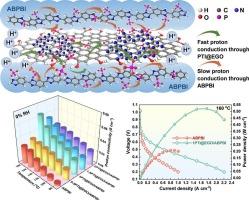Electrochemical exfoliation of poly(triazine imide)-coated graphene oxide for the in-situ synthesis of composite proton exchange membranes with enriched phosphoric acid channels
IF 13.2
1区 工程技术
Q1 ENGINEERING, CHEMICAL
引用次数: 0
Abstract
Phosphoric acid-doped polybenzimidazole (PA-PBI) membranes suffer from phosphoric acid (PA) loss, insufficient proton conduction sites, and severe plasticization, limiting their application in fuel cells. This work synthesized poly(triazine imide) (PTI) and poly(heptazine imide) (PHI) via ionothermal polycondensation, followed by the preparation of PTI-coated exfoliated graphene oxide (PTI@EGO) and PHI-coated exfoliated graphene oxide (PHI@EGO) nanosheets using electrochemical exfoliation. Structural characterization and theoretical calculations revealed strong interfacial interactions between PTI/PHI and exfoliated graphene oxide (EGO), effectively preventing the aggregation of EGO nanosheets. Furthermore, PTI@EGO provides more PA binding sites compared to PHI@EGO. Consequently, PTI@EGO was incorporated into poly(2,5-benzimidazole) (ABPBI) via in-situ polymerization to prepare PTI@EGO/ABPBI composite proton exchange membranes. The composite membranes exhibit exceptional mechanical strength, enhanced PA retention, and superior proton conductivity. Specifically, the ABPBI composite membrane containing 1 wt% PTI@EGO (1PTI@EGO/ABPBI) with a phosphoric acid doping level of 3.37 exhibited a tensile strength of 30 MPa, which is 1.5 times that of the pristine ABPBI membrane. The proton conductivity of the 1PTI@EGO/ABPBI membrane exceeded 0.01 S cm−1 across a wide-temperature range (40–180 °C). At 180 °C/0 % relative humidity (RH), the conductivity reached 66 mS cm−1, 2.44 times higher than that of pure ABPBI. The single-cell assembled with the 1PTI@EGO/ABPBI membrane delivered a peak power density of 0.522 W cm−2 at 160 °C, nearly 2.51 times that of the pure ABPBI membrane. These results indicate that PTI@EGO constructs PA-enriched, efficient proton conduction pathways within the ABPBI membrane.

电化学剥离聚三嗪亚胺包覆氧化石墨烯原位合成富磷酸通道复合质子交换膜
磷酸掺杂聚苯并咪唑(PA- pbi)膜存在磷酸(PA)损失、质子传导位点不足和严重的塑化等问题,限制了其在燃料电池中的应用。本文通过离子热缩聚法合成了聚三嗪亚胺(PTI)和聚七嗪亚胺(PHI),然后利用电化学剥离法制备了PTI包覆的剥离氧化石墨烯(PTI@EGO)和pi包覆的剥离氧化石墨烯(PHI@EGO)纳米片。结构表征和理论计算表明,PTI/PHI与脱落的氧化石墨烯(EGO)之间存在强烈的界面相互作用,有效地阻止了EGO纳米片的聚集。此外,与PHI@EGO相比,PTI@EGO提供了更多的PA结合位点。将PTI@EGO加入聚(2,5-苯并咪唑)(ABPBI)中,通过原位聚合法制备PTI@EGO/ABPBI复合质子交换膜。复合膜表现出优异的机械强度、增强的PA保留率和优异的质子导电性。其中,含1 wt% PTI@EGO (1PTI@EGO/ABPBI)、磷酸掺杂量为3.37的ABPBI复合膜的抗拉强度为30 MPa,是原始ABPBI膜的1.5倍。在较宽的温度范围(40-180 °C)内,1PTI@EGO/ABPBI膜的质子电导率超过0.01 S cm−1。在180 °C/0 %相对湿度(RH)下,导电率达到66 mS cm−1,是纯ABPBI的2.44倍。用1PTI@EGO/ABPBI膜组装的单电池在160 ℃下的峰值功率密度为0.522 W cm−2,是纯ABPBI膜的近2.51倍。这些结果表明PTI@EGO在ABPBI膜内构建了富含pa的高效质子传导途径。
本文章由计算机程序翻译,如有差异,请以英文原文为准。
求助全文
约1分钟内获得全文
求助全文
来源期刊

Chemical Engineering Journal
工程技术-工程:化工
CiteScore
21.70
自引率
9.30%
发文量
6781
审稿时长
2.4 months
期刊介绍:
The Chemical Engineering Journal is an international research journal that invites contributions of original and novel fundamental research. It aims to provide an international platform for presenting original fundamental research, interpretative reviews, and discussions on new developments in chemical engineering. The journal welcomes papers that describe novel theory and its practical application, as well as those that demonstrate the transfer of techniques from other disciplines. It also welcomes reports on carefully conducted experimental work that is soundly interpreted. The main focus of the journal is on original and rigorous research results that have broad significance. The Catalysis section within the Chemical Engineering Journal focuses specifically on Experimental and Theoretical studies in the fields of heterogeneous catalysis, molecular catalysis, and biocatalysis. These studies have industrial impact on various sectors such as chemicals, energy, materials, foods, healthcare, and environmental protection.
 求助内容:
求助内容: 应助结果提醒方式:
应助结果提醒方式:


